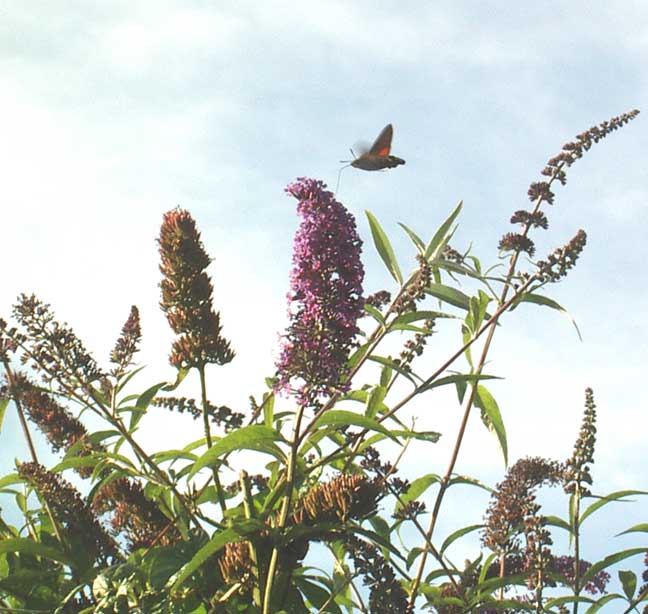Caterpillar
of the Elephant Hawk-moth, Deilephila
elpenor
Park
Avenue, Shoreham
Photograph
by Janie Mott
facebook
3 September 2021
Caterpillar
of the Elephant Hawk-moth, Deilephila
elpenor
Park
Avenue, Shoreham
Photograph
by Janie Mott
facebook
Poplar Hawk-moth at Old
Shoreham
Photograph
by Andy Berry
facebook
9 August
2019
A
large 10 cm long yellow caterpillar of the Death's
Head Hawk-moth, Acherontia
atropos, was discovered in a north
Lancing garden. The moth is the largest moth
to appear in Britain, sporting a wingspan of up to 12 or 13 cm, a striking
species, though it is not native. Immigrants arrive from southern Europe,
usually several in each year, during the late summer and autumn.
5 November
2018
An
immigrant Hummingbird Hawk-moth,
Macroglossum
stellatarum,
visited
a purple Salvia flower in
a Shoreham town back yard.
12
August 2018
Larva
of the Privet Hawk-moth, Sphinx
ligustri
Connaught
Avenue, Shoreham
Photograph
by Mikey Unsted
25
September 2015
 |
 |
|
Photograph by Lorraine Courant |
Photograph by Trev Smith |
Cats
brought in two large caterpillars, one reported by Lorraine
Courant as green with white dots and bluish
horn (and a brown hind end) was most likely the larva of a Lime Hawk-moth,
Mimas
tiliae, and the other one reported by
Trev
Smith was recognisable as the larva of
the Elephant Hawk-moth, Deilephila
elpenor.
Adur
Moths
31 July 2015
.jpg)
Elephant Hawk-moth
| 15
September 2012
A large green caterpillar of the species Eyed Hawk-moth, Smerinthus ocellata, was brought in by a domestic cat in Lancing. The warts or bumps on the skin are important for identification from similar species like the Convolvulus Hawk-moth, Agrius convolvuli. Report
and Photograph by Pete Elliott
|
 |
 |
Late
April 2007
The Convolvulus Hawk-moth, Agrius convolvuli, hatched out into the adult female imago. The caterpillar was discovered by Paul Graysmark on 29 October 2006 and it had buried into the soft earth on 30 October 2006 to metamorphises into the pupae. It was kept in a controlled environment by Richard Poxon who recorded its emergence. Caterpillar Report |
 |
 |
Paul Graysmark rescued a caterpillar of the immigrant Convolvulus Hawk-moth, Agrius convolvuli, from being squashed as it slowly crawled across Corbyn Crescent, Shoreham (TQ 224 052). This specimen was the green variant (this is not illustrated in the books). The caterpillars feed on Common Bindweed, but they cannot survive a British winter. The horn is at the hind end. The dark red spots differentiate it from the Privet Hawk-moth caterpillar. Separation from the Poplar Moth caterpillar was more difficult. The absence of the Poplar's food plant was the first clue.
 |
 |
 |
The caterpillar measured approximately 85 mm. The controlled environment consists of a container of loose dry earth in which the caterpillar will bury into to a depth of about 15 cm to metamorphosise into a pupae. The temperature will be controlled above 4° C so that the moth will hatch in spring when the new Bindweed growths will appear.
So
imminent was the transformation that in less than 30 minutes after the
caterpillar was placed into the container, it had buried into the soft
earth on 30 October 2006.
Other Caterpillars & Imago
 |
 |
Photographs by Richard Poxon
Eggs,
Larvae and Pupae of Butterflies and Moths
U.K.
Lepidopterists Study Group Forum
Life
Cycle Photographs: Egg to Pupa
2 September 2006
The distinctive caterpillar of the Elephant Hawk-moth, Deilephila elpenor, was discovered in the middle of Nicolson Drive in residential Shoreham (an area with large gardens). As it was imminent danger of being squashed it was removed to a garden. The caterpillar was not measured, but estimated to be about 70 mm in length. The larvae feed mainly on Rosebay Willowherb (Epilobium angustifolium), but also other plants as well, including Bedstraw (Galium). The caterpillar was released into my garden as there was plentiful Bedstraw.
 |
 |
||
|
|
was just a speck in the Hawthorn tops |
21
August 2006
My
first Hummingbird Hawk-moth since
2
July 2006 and only my second of the year
flew around the Buddleia
on the Coastal Link Cyclepath just south
of the Toll Bridge, Old
Shoreham.
2 July
2006
It
was the warmest day of the year so far as the air temperature measured
29.8 ºC at 4:16 pm. This
was the warmest temperature that I have ever recalled.
It
was a surprise to see the first Hummingbird
Hawk-moth of the year whirring around
my uncut Garden Privet hedge before flying
on. This was much earlier in the year than their normal first appearance.
 |
7
August 2005
The first (1984) Hummingbird Hawk-moth, Macroglossum stellatarum, of the year landed in a Shoreham garden: it flew off rapidly when tickled. It appeared to have chosen a rockery as a roosting place.
|
3
September 2004
Ray
Hamblett's south Lancing garden (TQ
186 044) with best view and highlight of the
day of a Hummingbird
Hawk-moth visiting the purple Buddleia
in the same back garden.
 |
 |
| 18
June 2006
The dead flowerhead twitched and moved, and it turned out to be a large moth, the Eyed Hawk-moth, Smerinthus ocellata, discovered in a Southwick garden. |
 |
 |
 |
An attractive Eyed Hawk-moth, Smerinthus ocellata, was discovered on a Daffodil in my garden in Mill Hill Gardens, which was at one time part of Mill Hill.